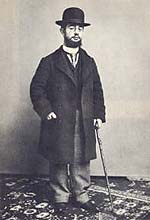| Biography of Henri de Toulouse-Lautrec (1864 - 1901) |
|

|
The Moulin Rouge, Toulouse-Lautrec's first poster, radicalized poster imagery. Drawing on his knowledge of Japanese prints, Lautrec changed the relationship of foreground and background, played with spacial relationships and abandoned the beautiful for the appeal of contrasts. While Lautrec's reputation was secured first as a posterist and secondarily as a fine artist, his penchant for simplicity and elimination of detail moved the entire art world toward abstraction, profoundly shaping the aesthetic sensibility of the twentieth century.
Henri Marie Raymond de Toulouse-Lautrec-Monfa was born to an aristocratic family on November 24, 1864 in Albi France. As a boy he covered his schoolbooks with drawings of animals and people. At 14, already beset by crippling disease, he began his art studies with the animal painter Rene Princeteau in Paris. Four years later, he decided to take up permanent residence in the bohemian quarter Montmartre in order to study art seriously.
Montmartre was a center for the irreverent and the irrepressible. Flouting social and artistic convention, the inhabitants of Montmartre provided Lautrec with subjects, compatriots, and patrons. His companions included the likes of Degas and Van Gogh while his sponsor's included the notorious Aristide Bruant whose likeness is seen in several of Lautrec's most well known posters. Fitting in well among those who disregarded tradition, Toulouse-Lautrec's drawings and paintings were the uncensored account of the lives around him. Parisians of his day thought his paintings 'hideous.'
Not so his posters. Strongly impressed by Pierre Bonnard's poster 'France-Champagne,' Toulouse-Lautrec decided to pursue lithography. Working with Bonnard and his printer Ancourt, Lautrec produced his first poster, the 'Moulin Rouge'. The poster created an immediate sensation and made Lautrec's reputation. He studied lithography in depth and went on to produce 400 lithographs, 31 of which were posters.
Lautrec painted characters and scenes from a personal point-of-view, giving the public a glimpse of his eccentric lifestyle. Although he understood and, some might say even exploited, the commercialism of the advertising poster, neither his unique aesthetic nor his sense of principle was compromised. When one of his posters almost caused an international incident, he refused to recall it from distribution. Subsequently, the value of his work quadrupled.
Yet the same eccentric lifestyle took its toll. Toulouse-Lautrec died at thirty-six. What further contribution this man of unusual vision and talent would have made can only be speculated. |
|
|